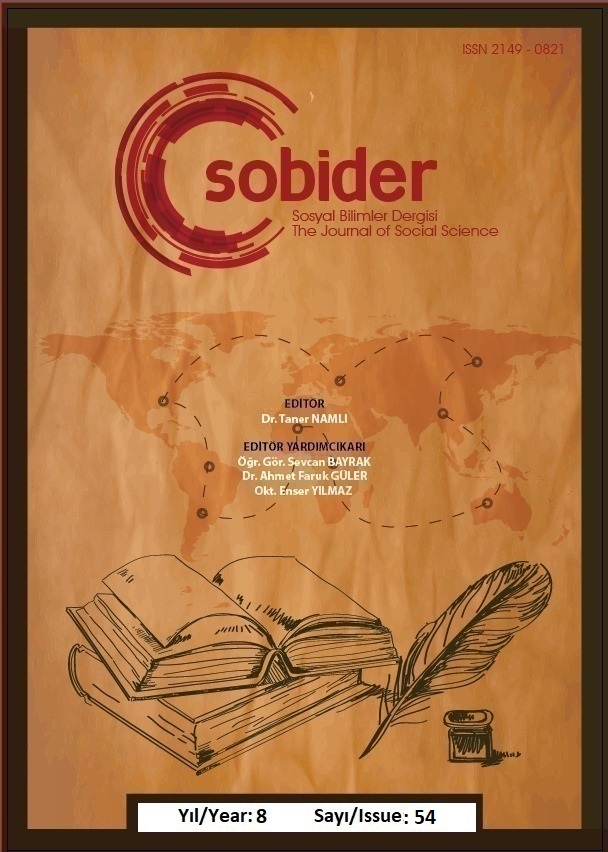Author :
Abstract
Dijital teknolojilerle birlikte kişiler arası iletişim ve kitle iletişim iç içe geçmeye başlamış, izleyiciler kendi mesajlarını üretip bu mesajları kitlelere yayabilir hale gelmişlerdir. 2000li yıllardan itibaren sosyal medya platformları ve bu platformların toplam kullanıcı sayıları hızla artmış, bugün milyarlarla ifade edilen kullanıcı sayılarına ulaşmışlardır. İçerik üreten kullanıcılar bu platformlar üzerinden hem kitlelere ulaşabilme hem de gelir elde edebilme imkanına sahip olmuşlardır. Bu çalışmada kullanıcıların medya tercihleri araştırılmıştır. Hangi kullanıcıların hangi konularda hangi medya platformunu tercih ettikleri, bu platformlar üzerinde içerik üretip üretmedikleri, ürettikleri içerikler karşılığında gelir elde edip etmedikleri ve dijital platformlara ödeme yapıp yapmadıkları incelenmiştir. Çalışma verileri çevrim içi ortamda 1112 kişi ile yapılan anket sonucunda elde edilmiştir.
Keywords
Abstract
With digital technologies, mass communication and interpersonal communication have begun to combine, audience has become able to produce their own messages and spread these messages to the masses. Beginning from late 2000s, social media platforms and number of users they have increased rapidly. Today they have reached total numbers of users expressed in billions. Users who produce content have the oppurtunity to reach masses and generate income for their content through these platforms. In this study, the media preferences of the users were analyzed. Which users prefer which media platform for which topics, whether they produce content on these platforms, whether they produce content on these platform, whether they generate income for their content and whether they pay for any digital platform have been examined. The study data obtained from the results of an online survey conducted with 1112 people.
Keywords
- Bruns Axel, Joanne Jacobs, Uses of Blogs, Peter Lang Publishing, New York, 2006.
- Bruns, Axel, Towards Produsage: Futures for User-Led Content Procution, (Sudweeks, Fay and Hrachovec, Herbert and Ess, Charles, Eds. Proceedings Cultural Attitudes towards Communication and Technology, pages pp. 275-284, Tartu, Estonia), 2006.
- Bruns, Axel, The Future is User-Led: The Path towards Widespread Produsage, (Fibreculture Journal, Vol. 11), 2008.
- Castells Manuel, Enformasyon Çağı: Ekonomi, Toplum ve Kültür, (İkinci Cilt: Kimliğin Gücü), İstanbul Bilgi Üniversitesi Yayınları, (Çeviren: Ebru Kılıç), İstanbul, 2006.
- Castells Manuel, İletişim Gücü, (Çeviren: Ebru Kılıç) İstanbul Bilgi Üniversitesi Yayınları, 2016.
- Cochran William G., Sampling Techniques, Third Edition, John Wiley&Sons, New York, Toronto, 1977.
- Dahlgren Peter, The Internet, Public Spheres, and Political Communication: Dispersion and Deliberation, Political Communications, (22:2), https://doi.org/10.1080/10584600590933160, (erişim tarihi: 04.12.2020), 2006.
- Dahlgren Peter, The Political Web: Media, Participation and Alternative Democracy, Palgrave Macmillan, Hampshire, New York, 2013.
- Fuchs Christian, Sosyal Medya: Eleştirel Bir Giriş, Notabane Yayınları, (Çeviren Diyar Saraçoğlu, İlker Kalaycı), İkinci Baskı, İstanbul, 2020.
- Gall Meredith D., Gall Joyce P., Borg Walter R., Educational Research, An Introduction, Seventh Edition, Allyn&Bacon, Boston, 2002.
- Jenkins Henry, Ford Sam, Green Joshua, Spreadable Media: Creating Value and Meaning in a Networked Culture, New York University Press, New York and London, 2013.
- Kırık Ali Murat, Yeni Medya Çağı Çerçevesinde Türkiye’de Televizyondan İnternete Dönüşüm ve Sosyal Paylaşım Ağlarında Gençlerin Konumu, Marmara Üniversitesi Sosyal Bilimler Enstitüsü Radyo Televizyon ve Sinema Anabilim Dalı Radyo Televizyon Bilim Dalı, Doktora Tezi, İstanbul, 2013.
- Kline Paul, An Easy Guide to Factor Analysis, Routledge, London and New York, 1994.
- Lister Martin, Dovey Jon, Giddings Seth, Grant Iain, Kelly Kieran, New Media: A Critical Introduction, Routledge, London, New York, 2009.
- Shirky Clay, Here Comes Everybody: the Power of Organizing Without Organizations, Penguin Books, London, 2008.
- Shirky Clay, Cognitive Surplus Creativity and Generosity in a Connected Age, The Penguin Press, (ebook version), 2010.
- Toffler Alvin, Üçüncü Dalga, Koridor Yayıncılık, (Çeviren: Selim Yeniçeri, İstanbul, 2008.
- Van Dijck Jose, Neiborg David, Wikinomics and Its Discontents: A Critical Analysis of Web 2.0 Business Manifestos, New Media & Society, Volume 11(5): 855-874, Sage Publications, 2009.
- Hootsuite & We Are Social (2021), Digital 2021: Global Overwiew Report, https://datareportal.com/reports/digital-2021-global-overview-report (erişim tarihi 01.09.2021)
- IBM, KMO and Bartlett’s Test, https://www.ibm.com/docs/en/spss- statistics/23.0.0?topic=detection-kmo-bartletts-test (erişim tarihi: 01.09.2021)
- Taber, Keith S., The Use of Cronbach’s Alpha When Developing and Reporting Research Instruments in Science Education, 2016, https://www.researchgate.net/profile/AbbasHussein-5/post/What-is-the-acceptable-range-for-Cronbach-alpha-test-ofreliability/attachment/5f17478f5e3fff000179446f/AS%3A915825267593220%4015953 61167801/download/UseofCronbachsAlphaWhenDeveloping.pdf (erişim tarihi: 01.09.2021).
